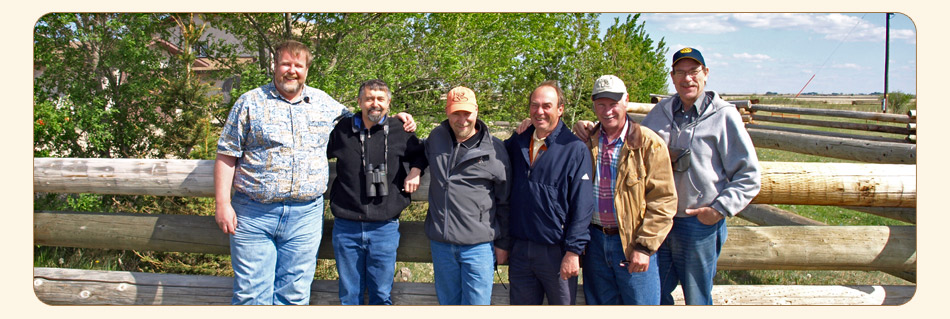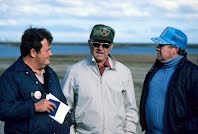



2. Technical Committee Membership
3. Ranch Mangers
Research related to crested wheat field production and utilization, irrigated flood/pivot field production and native range has been ongoing since the purchase date - in 2004, overall “range health” was measured for the first time, however, and clearly demonstrated that the new rotational grazing system has benefited both cattle and wildlife.
The 5,500 acre property, formerly part of the Ward Ranch, was purchased through a partnership including the then Alberta Fish and Wildlife Division, AFGA, WHC and DUC in 1986 under a 25 year, joint miscellaneous lease; ranch operations are subject to an official management agreement that expires in 2015 which was subject to amendment in 2010. Officially, the joint miscellaneous lease was issued to the AFGA. Upon termination of this lease, the provincial government is required to issue a new lease, consistent with the intent respecting the overall objectives of the original lease.
All revenues received from ranch operations by the lessee (AFGA) are to be held in trust and are not to be disposed of except in accordance with the original management agreement. These revenues are to be held in a separate account called the Antelope Creek Trust Account. The lease is subject to agreements with then Pan Canadian Energy Corporation (currently EnCana Corporation) oil and gas interests in place at the time of the contract signing date – February 4, 1986.
The overarching intent of the aforementioned management agreement will hinge on whether sufficient revenues are on hand at the termination of the lease to perpetuate current ranch operations. Revenue held in a trust account is managed as low interest money market investments which have a small financial risk. Subject to an investment policy that was developed and approved by the ACR board of directors, these funds, along with any future identified surpluses, have been invested with a professional investment advisor to enable the Antelope Creek Trust Account to reach as high a return as feasible, and still stay within conservative guidelines of the investment policy. The investment policy is subject to an annual review by the board of directors of the ACR management committee.
Annually, the approximate revenue line is $175,000 with a budget of $125,000 for ranch operations. It has been estimated that approximately $3 million will be required to sustain operations when the lease expires, in the context of present-day ranch operations. There are draft guidelines for funding projects in support of wildlife habitat conservation from the Antelope Creek Trust Fund; appropriations subject to these guidelines are being held in abeyance pending completion of a long-term financial plan, which was contingent on completion of a strategic plan for the ranch drafted in 2005 and subsequently modified for the period 2008-2018. While some oil and gas revenues have been previously disbursed for wildlife conservation purposes, at present the priority is to grow the trust account to ensure the long-term sustainability of the ranch. Financial statements are subject to an annual, independent audit.
 The official sod turning ceremony for the ACR occurred on October 4, 1986. Jack Shaver represented the AFGA at this ceremony, as president of the AFGA; the late Mr. Shaver deserves much of the credit for orchestrating the purchase of the ranch.
The official sod turning ceremony for the ACR occurred on October 4, 1986. Jack Shaver represented the AFGA at this ceremony, as president of the AFGA; the late Mr. Shaver deserves much of the credit for orchestrating the purchase of the ranch.
A management plan for the ranch was developed in 1987 to ensure that livestock operations, in particular, would continue as part of the ranch business plan to demonstrate multiple and compatible land use principles; key management objectives for the ACR are listed below:
- Protect, enhance and develop key wildlife habitat for upland birds, waterfowl and non-game species.
- Manage livestock grazing to benefit both wildlife and livestock, in order to demonstrate the benefits of complimentary grazing systems and gain community support for overall management objectives through integrated land use.
- Integrate petroleum and natural gas activity with wildlife habitat, recreation and grazing components.
- Provide primarily non-mechanized recreational opportunities.
- Provide education and research opportunities.
- To use all the “assets” of the property to the highest and best use and to ensure self-sufficiency.
In 1989, government legislation, subject to the Wildlife Act, was used to establish what is termed the “Antelope Creek Habitat Development Area” to regulate public access and activities on the ranch. Regulated access on the ACR benefits local wildlife such as white-tailed deer, antelope, foxes, coyotes, upland birds and waterfowl.
Initially, the ranch was managed by the technical committee under the direction of the management committee with members of both groups coming from the partners who were party to the original purchase agreement. Management by committee was seen as a non-starter, in the long run, and the founding members realized that eventually this would have to change to include a ranch manager who would live on the ranch.
Many people have represented the member organizations on the management committee and the technical committee over the years, as follows:
Management Committee:
Technical Committee:
Bob Kaufman was hired as the first ranch manager in 1994 to oversee the management objectives for the ACR and provide day-to-day continuity of all on-ranch operations. He resigned in 2005 to pursue other interests and was replaced by Neal Wilson and his wife, Shannon Burnard. In cooperation with members of the technical committee, Mr. Kaufman was responsible for setting livestock carrying capacity, developing an annual grazing schedule, coordinating livestock entry and exit dates, roundups, weighing movements and salting. He was the go-to person for local authorities, such as livestock patrons, the Eastern Irrigation District and grazing associations. He maintained and operated pivots and the irrigation water delivery system, flood irrigation cells for integrated use by livestock and wildlife. He took care of soil testing and fertilizer application of irrigated fields to maximize forage production. Extension services also fell under his purview; he was the front-line contact with the oil and gas industry respecting their operations on the ranch. He was also responsible for maintenance of shelterbelts for wildlife and operation of wetland basins to benefit wildlife – primarily waterfowl.
The 2004 Antelope Creek Ranch annual report paints a positive picture of range health in the four native pastures, as well as in a control field and “…demonstrates that range improvement through specialized grazing systems benefits both livestock and wildlife.” The number of cow/calf pairs pastured on the ranch was 260 in 2004. The native fields are grazed in a complimentary, deferred rotational system, with certain pastures left idle; grass production tends to increase or decrease depending on annual precipitation. An ungrazed exclosure traditionally has the highest amount of litter while a control field – grazed continually – has the lowest levels. Litter has increased in the native pastures under the deferred rotation grazing which benefits the native prairie grasses. All the forage indicators were rated as being satisfactory. However, the footprint of the oil and gas industry on the ranch is huge: at least 10 percent of the surface area of the ACR has been impacted by this industry since 1985. These disturbances take the form of pipelines, battery stations, roads and well sites. There has been ongoing reclamation activity of various disturbances but much remains to be done.
While the ACR is a success story, there are some nagging concerns: will it be able to stand on its own two feet when oil and gas revenues expire, with enough money in the bank for it to remain viable? Only time will tell, since a new ACR Habitat Development Area Investment Policy was approved by the management committee in 2005 in support of this goal. An objective of the management committee is to contribute approximately $50,000 in revenue annually towards the ACR endowment fund; the intent is for the endowment fund to support ranch operations in 2016 when oil and gas revenues are expected to decline.
The ACR is the flagship of all AFGA habitat properties and is unique in that it is the only one that is used on an ongoing basis for educational purposes. The ranch represents the first major venture of the AFGA as a partner in wildlife habitat management and protection in Alberta’s native prairies. It has been used extensively to educate the public about prairie conservation values associated with good range management. Some of the revenues from ranch operations have been used to purchase wildlife habitat for the AFGA which has been a voice for conservation since it was founded in 1908, as a secondary benefit.
Ranch Location: (See Map)
Go west from Brooks along Secondary Highway 542 ( Cassils Road ) and cross Highway 36, continuing west on the paved road until you reach a T-intersection. Turn left across the railway tracks and proceed south on a gravel road for 1 km, then turn right onto another gravel road, driving west approximately 5 km to the ranch entrance. Visitors are always welcome but are encouraged to stay on trails and park in designated areas.
Oil and Gas Operations:
Pan Canadian Energy Corporation changed its name to EnCana Corporation following a merger with the Alberta Energy Corporation in 2002. Their head office is in Calgary, Alberta and they have a field office in Brooks which is responsible for their play on the ACR. Approximately 600 acres of the ranch has been disturbed by oil and gas operations during the past 10 years - which represents about 10 percent of the area of the property - consequently landscape fragmentation and cumulative impacts on native range are an issue. These disturbed lands are a liability and it is incumbent on EnCana Corporation to satisfactorily reclaim them. More recently, Pengrowth Energy Trust has also developed both oil and gas plays on the ACR.
Alberta Emerald Awards:
The ACR has received recognition for its achievements, notably as a recipient of a 1996 Alberta Emerald Awards for Research and Innovation.
Antelope Creek Ranch Technical Committee, Brooks:
The principle is, if it works on the Antelope Creek Ranch, why not everywhere else as well? The ranch is a 5,500 acre working concern in the dry, mixed grass prairie west of Brooks. Managed by the technical committee - comprised of members from Alberta Environment and Sustainable Resources Development, Ducks Unlimited Canada, and the Alberta Fish and Game Association - it looks for ways to integrate often competing land uses to maintain landscape health, biodiversity and economic use. It applies sound land management practices that demonstrate the benefits of diverse land use integration, and then communicates its findings to wider audiences: landowners, livestock producers, industry, conservationists, academia, and government. The ranch also hosts annual field days, provides applied research opportunities and training to post-secondary students, and gives presentations to a wide range of interested groups.